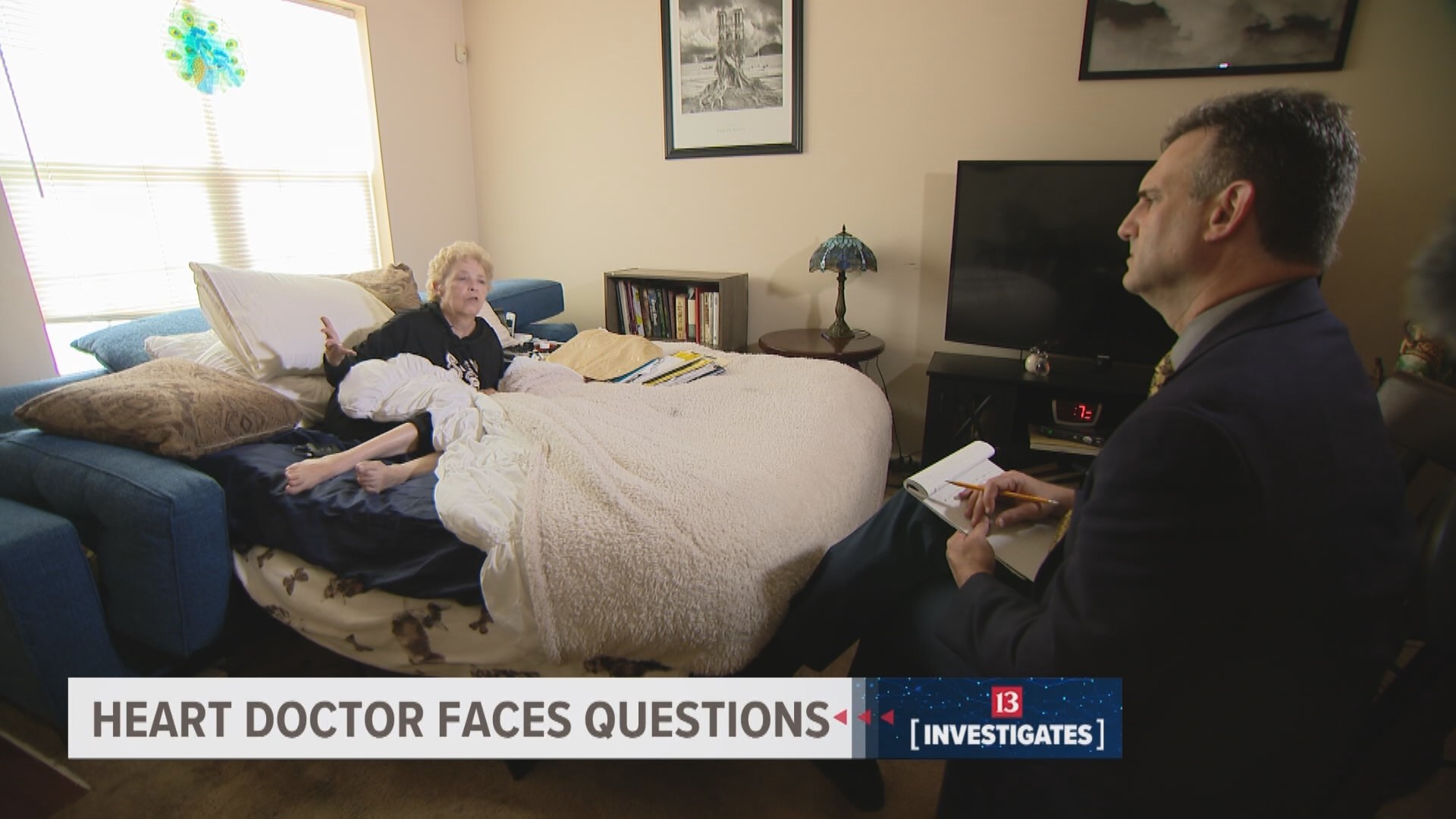Heart Broken: Patients claim Indiana heart doctor subjected them to unnecessary cardiac procedures
Lawyers for the longtime cardiologist told 13News the doctor provides his patients with quality care. However, several former patients are now alleging malpractice.
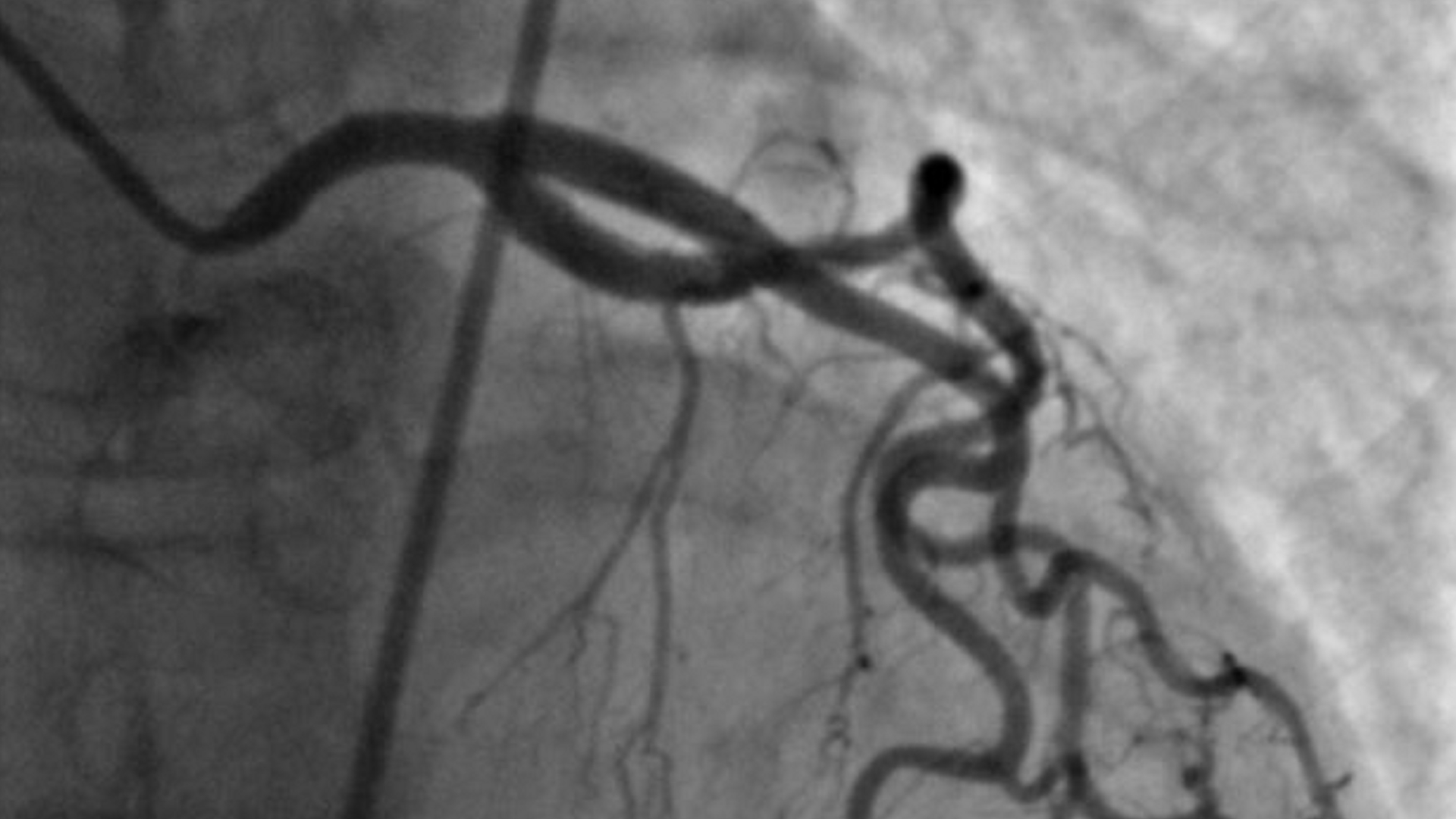
John Pflum says he is grateful to be alive, but he admits there were many days he did not feel that way.
The 70-year-old retired hospital worker says he became suicidal following dozens of cardiac procedures performed by an Indianapolis cardiologist. Medical records show that doctor implanted 41 stents in Pflum's chest.
“I was in and out of the hospital every few weeks for years. Every time, they tell you there’s the danger of death, and that’s in your mind every time,” Pflum told 13News. “It began to wear on me emotionally. It got so bad, I just wanted it over with.”
Pflum and other patients are now speaking out about the longtime cardiologist who, they say, subjected them to unnecessary heart procedures.
That cardiologist, Edward Harlamert, has been treating patients at some of central Indiana’s largest and most well-known hospitals for more than 30 years. His attorneys told 13News, “Dr. Harlamert has always been committed to providing quality care to patients” and he treats those patients “based on their unique circumstances, his expertise and the tools available.”
However, seven former patients (including Pflum) have now filed malpractice complaints against Harlamert, alleging serious issues such as misdiagnosing heart conditions and performing unneeded cardiac procedures that resulted in severe and permanent physical injuries. Heart doctors who reviewed some of those patients’ medical records for 13 Investigates say they are stunned and concerned by what they see.
“A responsibility to come forward”
When 13News visited with Pflum earlier this year, he was in his home office, flipping though pages of his Bible. In his retirement, Pflum has chosen to be a pastor.
“You just let the Bible speak for itself a lot, I guess,” the white-haired grandfather said with a chuckle as he prepared his Sunday sermon.
What Pflum preached about during our visit – and the reason he and his wife, Susan, invited 13 Investigates into their Noblesville home – was to talk about their experience with Edward Harlamert.
“I feel it’s imperative I say something,” Pflum told 13News.
“I think our family has felt a responsibility to come forward publicly with this,” added Susan.


The Pflums have filed a malpractice complaint with the Indiana Department of Insurance that claims Harlamert performed “dozens of unnecessary” cardiac procedures on John while he was a patient at The Indiana Heart Hospital and at Community Heart and Vascular Hospital. According to detailed medical records kept by Susan, a registered nurse, the procedures were all performed from 2004 to 2013.
Back then, while John was a patient, both he and Susan considered Harlamert a hero.
“Our family felt like he saved John’s life over and over when in fact …,” Susan said, stopping to take a deep breath and search for the right words. “Well, he just did a horrible thing.”
Did the longtime cardiologist do something horrible – or was he simply trying to save his patient’s life?
After all, John does have a long history of heart disease. As a junior high cross country coach, he first started feeling chest pain and experiencing shortness of breath in his 40s as he ran with the boys he was coaching. In early 2004, he had open heart surgery.
“I had blockage in what they call the widow maker, and I received five bypasses at that time,” John said.
According to the Pflums, it was Harlamert who identified the blockages that led to the 2004 bypass surgery.
But it’s what happened after that surgery that John and Susan are now so concerned about – and they’re not alone.
13 Investigates asked four separate cardiologists to review John Pflum’s medical records and the care he received from Edward Harlamert. Those medical experts include:
- Qaisar Kahn, an interventional cardiologist who runs the Advanced Heart and Vein Surgery Center in Colorado
- Payal Kohli, a Harvard-trained cardiologist who serves as medical director at Cherry Creek Heart in Denver, and also works as the medical expert for KUSA-TV, which is owned by 13News’ parent company TEGNA
- Sunil Rao, the director of interventional cardiology at NYU Langone and president of the Society for Cardiovascular Angioplasty and Interventions (SCAI), the world’s leading medical society for interventional cardiology
- Morton Rinder, an interventional cardiologist and medical director of the heart attack program at St. Luke’s Hospital near St. Louis, who has also been hired as a medical consultant by the attorneys who filed malpractice complaints against Harlamert on behalf of several patients
Each of the doctors told 13News the same thing: some of the treatment Harlamert provided John Pflum did not follow an acceptable standard of care.


Procedures involved risks
To understand the allegations against Harlamert, you first need a basic understanding of how cardiologists treat cardiac disease.
When a patient complains of ongoing chest pain, doctors usually recommend a stress test to see how well the heart is pumping blood and if there are any blockages in arteries that supply blood to the heart.
If that test is abnormal, the next step is often a more invasive test called an angiogram, also known as a heart catheterization. It is performed by a heart specialist called an interventional cardiologist, and the test involves inserting a catheter – a thin tube – into a patient’s arm or groin area. The catheter is then guided through blood vessels to the heart, where a special dye and X-ray (fluoroscopy) can reveal clogged arteries.
If a blockage is detected during the catheterization, the interventional cardiologist performing the test may recommend opening the blocked artery using a tiny balloon – that’s called angioplasty – and then inserting a wire stent inside the blood vessel to help keep the section of artery open and to improve blood flow.
John experienced a lot of heart catheterizations. He had five of them performed by various doctors prior to his open heart surgery in 2004. Those doctors also implanted five stents, according to the Pflums’ medical records.
When he felt chest pains return a few years after his bypass surgery, John says that’s when the number of procedures began to rapidly increase. He said Harlamert would almost always offer to see him immediately to perform a heart catheterization.
“I would be having symptoms and he’d say, ‘Well, you’re having symptoms. Let’s just go in and take a look.’ That’s pretty much how he’d put it: ‘We better just take a look,’” John recalled of his phone conversations with Harlamert. “Typically, he wouldn’t give an alternative to it: let’s wait til tomorrow or try a different medication, let’s modify this, increase this. No, we would go straight to the cath lab. I thought this must be a good thing. He’s the doctor. He makes the call. I didn’t really question it.”
“If Dr. Harlamert said we need to do it, yes, let’s do it because I wanted to save my husband. I wanted my husband alive,” his wife added. “That’s all we really thought about.”
The Pflums’ medical records show during an 18-month period from 2007 to 2008, Harlamert performed 13 separate heart catheterizations and inserted at least 20 stents in John’s chest to increase blood flow in areas the doctor said were blocked.
“I mean, he was getting cathed almost every month. That’s not how it’s done,” said Missouri cardiologist Morton Rinder, an interventional cardiologist for 30 years who’s been hired as a medical consultant by the attorneys who filed John’s malpractice complaint against Harlamert. He told 13News that heart catheterizations should never be used on a monthly basis simply as a diagnostic tool.
“And the reason for that is because the procedure is invasive, and it has risks,” explained Denver cardiologist Payal Kohli.


While the American Heart Association states “cardiac cath is usually very safe” and “a small number of people have minor problems,” prominent cardiac hospitals list a number of serious complications that can result from heart catheterizations.
“The risks include bleeding, kidney failure, more serious complications like a heart attack, a stroke, a tear in the blood vessel,” Kohli said. “And in the worst case scenario, you can actually die from this procedure. That’s why we don’t take angiograms lightly.”
A heart catheterization also exposes patients to small amounts of radiation each time it is performed, according to Rinder.
Stents inside stents
Despite the risks, medical records show Harlamert continued to probe John’s arteries when he complained of chest pain, often telling John he found significant blockages that required stents.
When is a stent considered necessary?
By clinical guidelines, an artery should be about 70% blocked before a stent is placed, according to the American Heart Association.
Some of John’s blockages met that threshold, meaning a stent was medically justified, according to the cardiologists who reviewed his cath films for 13News.
But the experts say other arteries that Harlamert chose to stent seem nowhere near 70% blocked.
For example, a stent that Harlamert placed in a branch of John’s circumflex artery on Oct. 26, 2007, appeared to have very little blockage, according to Drs. Rinder and Kahn.
“Maybe 20%,” said Rinder, the Missouri cardiologist, as he looked at the cath film.
“More like 30%,” said Kahn, pointing to the area that Harlamert chose to stent.
“You don’t need to open a 30% blockage,” Rinder added.
“Every blockage does not need a stent,” agreed Kohli. “In fact, the guidelines recommend against putting in a stent [for minor blockages], because at least in the short term, you increase their risk of having a heart attack by putting in a stent rather than reducing it.”

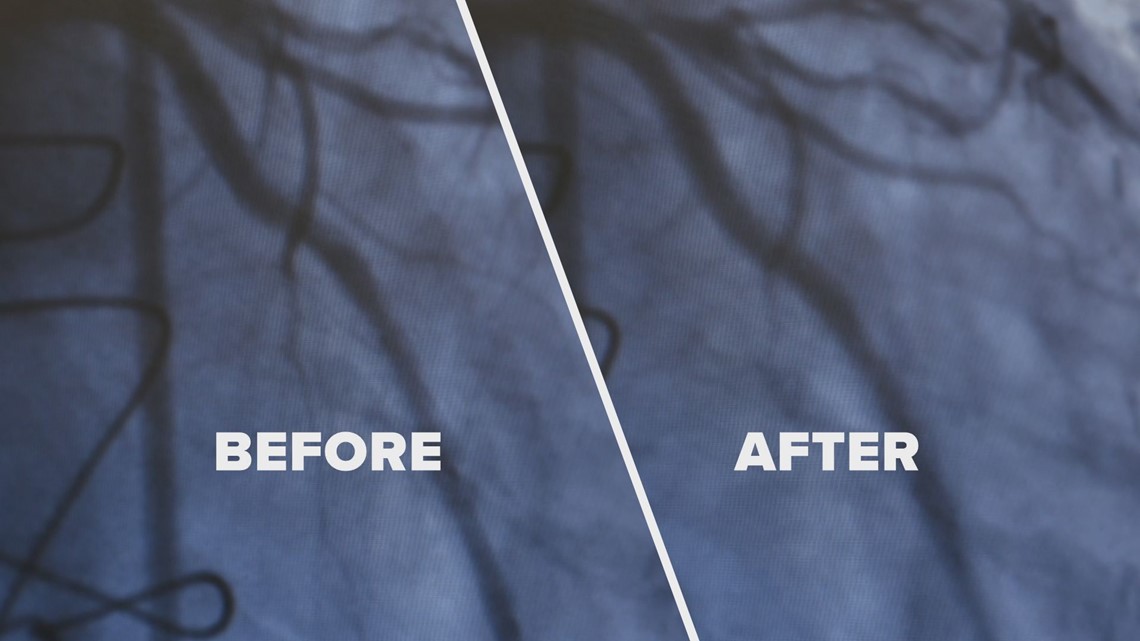
Kohli is referring to a phenomenon called in-stent restenosis, which can occur after an angioplasty balloon is inflated and a stent is placed inside an artery. Those cardiac interventions can sometimes result in damage to the wall of the blood vessel, causing scar tissue to form and creating a new blockage inside the stent. She said the procedures can also cause plaque along the wall of a blood vessel to shift or dislodge, creating the risk of another blockage, a heart attack or a stroke.
In-stent restenosis is exactly what happened inside several of the stents that Harlamert implanted in John Pflum, according to Kahn. The Colorado heart doctor identified scar tissue that formed repeatedly inside some of John’s newly implanted stents.
After Harlamert inserted at least 20 stents in John’s arteries in less than two years – including more than a dozen stents in his left internal mammary artery (LIMA) – many of those stents became blocked with re-stenosis, requiring John to undergo a second open heart surgery in October 2008.
“There’s layers of stents. You’re putting wire mesh inside wire mesh inside wire mesh,” Rinder said. “In general, the more stents you put in, the more likely it is just to scar down and close down eventually. That’s what happened.”
“Yeah, putting more stents in actually made things worse. No question,” added Kahn.
And even then, Harlamert continued to perform more procedures and implant more stents in John’s chest. A lot more.
“Can’t imagine putting someone through that”
Medical records kept by the Pflums show during a seven-year stretch, the heart doctor conducted a total of 44 heart catheterizations and inserted at least 41 stents in John – more than any of the heart doctors interviewed by 13News have ever seen in a single patient.
Asked to explain the treatment he provided John Pflum, Dr. Harlamert’s attorneys told 13 Investigates, “Because of stringent privacy laws and pending litigation, a response to a local news story is not the proper forum to present a picture of any particular treatment decision, especially when that picture may be incomplete at this time.”
The doctors consulted by 13 Investigates say they cannot think of any scenario that would justify 44 heart catheterizations and 41 stents for a patient.
“No, there is not a single scenario I can think of where doing this level of stents and angiograms would be justified or make sense,” Kohli said. “I have never seen this happen in the course of my medical training or my medical career.”
“I have never seen a patient who has gotten this many procedures,” added New York cardiologist Sunil Rao after reviewing John’s medical records. “If you’re going to do the same thing over and over again and expect a different result, you’re probably making an error in judgment… At some point, someone should have said, ‘What we’re doing here is not working.’”

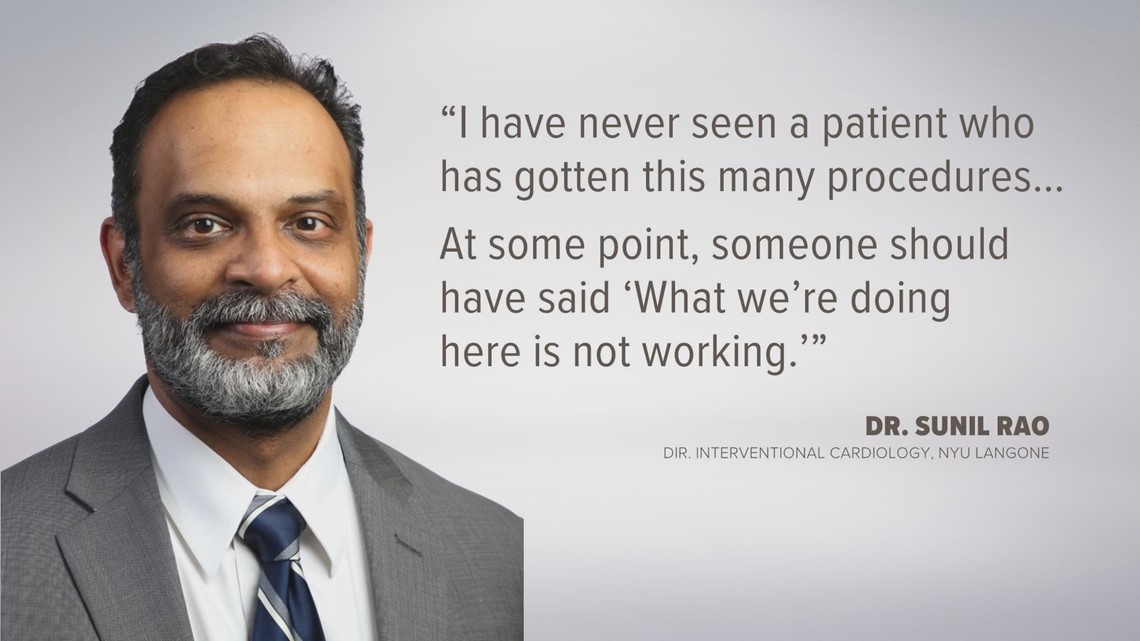
Rinder agreed. “It’s unheard of. I can’t even imagine putting someone through that,” he said. “As doctors, we’re taught to re-evaluate patients all the time and make sure what we’re doing is helping them. And if we’re not helping them, it’s time to re-think your strategy.”
Harlamert declined 13 Investigates’ request for an interview and would not answer any of the questions sent by 13News.
His attorneys say the doctor’s response will come through Indiana’s medical review process, where the parties have the opportunity to conduct discovery and investigate the claims before facts and evidence are presented to an unbiased medical review panel comprised of medical professionals. Those panels consist of three doctors with an attorney serving as the panel chair to collect evidence from both parties.
If a medical review panel considers John’s case, it will have to decide whether Harlamert “failed to comply with the appropriate standard of care” before rendering a decision.
Heart doctors tell 13News, interventional cardiology tends to be an inexact science, where trained cardiologists can interpret the same images differently. Yet the doctors consulted by 13 Investigates all seem to agree on the records they have reviewed so far:
“Based on what I saw in the records and in the images, there were several areas that I felt did, in fact, deviate from the standard of care,” said Rao.
“John’s treatment did not follow the standard of care,” Kohli told 13News.
“That’s not standard of care,” Rinder said.
“Standard of care? Absolutely no. This wasn’t standard of care,” agreed Khan.
Harlamert currently works at Witham Health in Boone County after spending many years treating patients though Community Health, Indiana University Health and The Indiana Heart Hospital.
A shocking discovery
John and Susan say all of the procedures and the repeated trips to hospitals and cath labs turned their lives upside down.
“Our lives became a nightmare,” said Susan, who kept a suitcase packed in anticipation of what would become monthly trips to the hospital for her husband’s heart catheterizations. “I felt like a soldier all the time that could not rest, could not sleep. I was on guard waiting for the next emergency because it always came, and we believed it was real. My fear always was ‘Is John going to die today? Is he going to die in the cath lab tomorrow when he goes?’ Being told John needed all those caths … really changed our lives forever.”

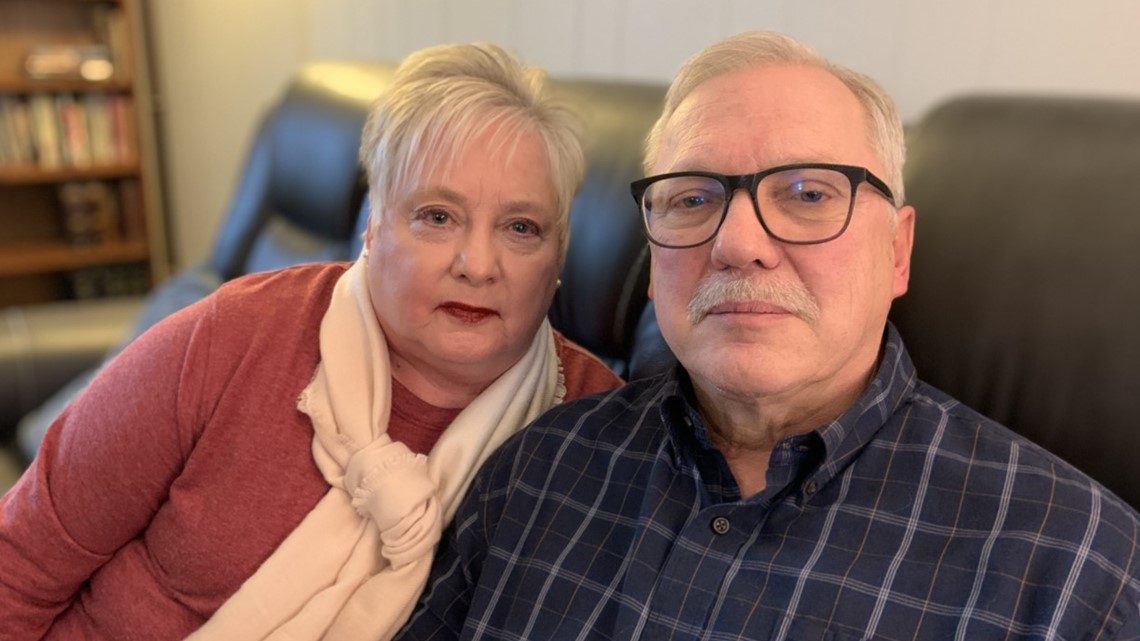
With each painful procedure, John recalls feeling more and more anxious. His outgoing personality faded. He lived in constant fear of experiencing chest pain that would mean another call to his cardiologist and another trip to the cath lab.
“It got so I couldn’t deal with it and began to withdrawal,” he said. “I wanted to sit in the corner honestly, just sit in the corner. I was a mess.”
John remembers the day he told his wife to hide the gun they keep in their home. He says he was so filled with panic and depression over his frequent heart procedures, he wasn’t sure what he might do.
“I felt I was a danger to myself,” he said. “It got that bad.”
During a six-month stretch in 2008 that included nine catheterizations and 14 stents, trips to the cath lab got harder and harder.
“He needed to be sedated to even get in the car and go,” Susan recalls. “He’d beg me, ‘Susan, please don’t take me. I can’t do this.’ But I knew I had to take him. This is what we had to do. This was necessary. We were maybe going to save his life today.”
At least that’s what they say they were led to believe by Harlamert.
“We trusted him completely, and he truly made us believe that John needed all these caths and all these stents when, in fact, we now realize that he did not,” said Susan.
The Pflums say that realization did not come until Harlamert left to work at another local hospital and new cardiologists started reviewing John’s medical records.
“One said it was alarming. One said it was disgusting and disturbing. And that was shocking to me because of the trust,” John told 13News. “Suddenly I’m looking at this, saying ‘How could anyone do this’ … and could there be others?’”
More complaints filed
The Pflums are not alone in voicing concerns about the cardiac care provided by Harlamert.
A total of seven patients have filed malpractice claims against Harlamert in the past seven years – more complaints than almost any other interventional cardiologist in Indiana over that same time.
Indiana’s Department of Insurance lists 932 licensed doctors with a heart catheterization specialty. Only four of those doctors – including Harlamert -- have seven or more malpractice complaints filed with the state since 2015, according to IDOI’s online database.
Of the seven complaints, a medical review panel determined in one case that Harlamert “failed to comply with the appropriate standard of care.” The specific allegations and settlement are confidential, but state records show the patient received a court settlement of at least $187,000 and a $750,000 payment from the state’s patient compensation fund.
In another case, a medical review panel sided with Harlamert, determining the evidence did not show that he failed to meet the applicable standard of care.
The other five cases, which name both Harlamert and the health care providers he worked for, are still open and waiting for a medical review panel to review them.

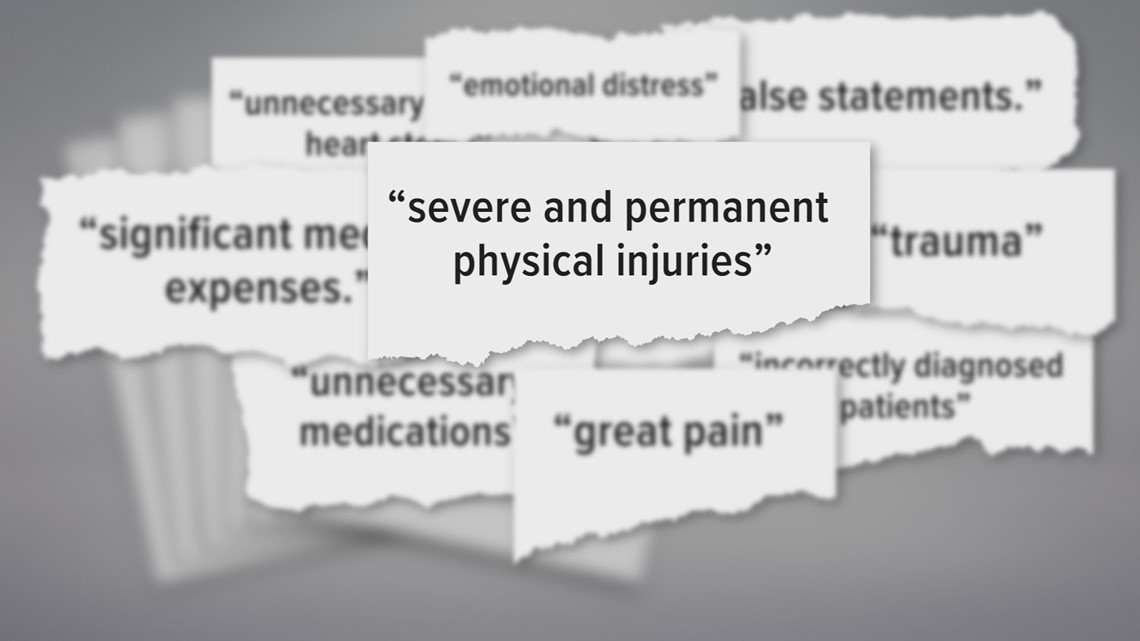
In those complaints, former patients claim Harlamert performed unnecessary cardiac catheterizations, implanted unnecessary coronary heart stents, incorrectly diagnosed patients, prescribed unnecessary medications and made false statements. And the claims allege the doctor’s negligence resulted in great pain, emotional distress, trauma, significant medical expenses and severe and permanent physical injuries.
David Cutshaw, an attorney at Cohen & Malad in Indianapolis, and Barry Rooth, a partner at Merrillville-based law firm Theodoros & Rooth, both specialize in medical malpractice law. They represent several of the patients who filed complaints against Harlamert, and the lawyers told 13News the claims are intended to sound an alarm.
“The only way to stop this type of behavior is through litigation,” said Cutshaw.
“He ruined my life”
Carlotta Lawton is one of the patients who has a pending malpractice complaint against Harlamert. She filed the claim earlier this year and agreed to discuss the complaint with 13News to raise awareness about her concerns.
“He ruined my life,” Lawton told 13News from her bed inside her Lebanon home. “I’m in pain 24/7 and there’s no way you can get out of it.”

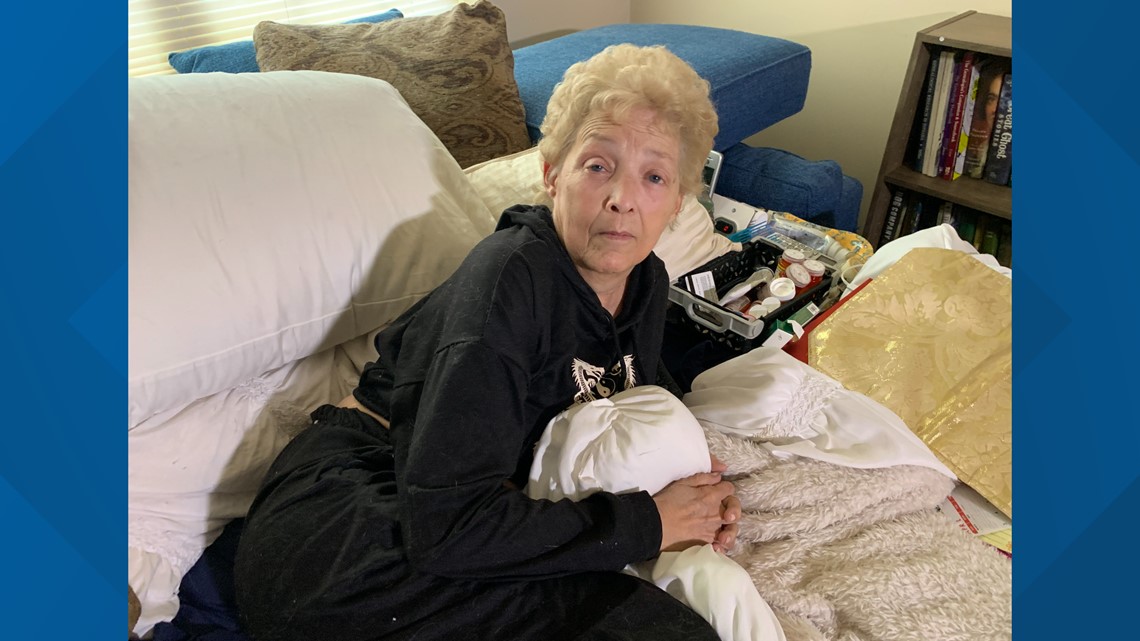
Lawton saw Harlamert two years ago at Witham Hospital in Lebanon. She says her main complaint was a migraine headache, which she experiences frequently, but Harlamert diagnosed her with something else.
“He took one look at me and said, ‘You’re having a massive heart attack,’” she recalls about her ER visit in 2020.
Medical records from Lawton’s hospital stay show Harlamert recommended performing a heart catheterization, and during that procedure, the cardiologist said Lawton’s left anterior descending artery, also known as an LAD, was 75% blocked. He inflated a tiny balloon and implanted a stent to open the blockage.
But was the stent necessary?
13 Investigates asked our panel of heart specialists to review the same images that Harlamert saw during Lawton’s heart cath. They told us the blockage in Lawton’s artery looked much less than 75%, and far below the 70% considered medically necessary to justify a stent.
“I see right in this area, probably a 50% or so narrowing,” said Colorado cardiologist Qaisar Kahn. He told 13News he would not have placed a stent in Lawton’s LAD. “Not without further evaluation,” he said.

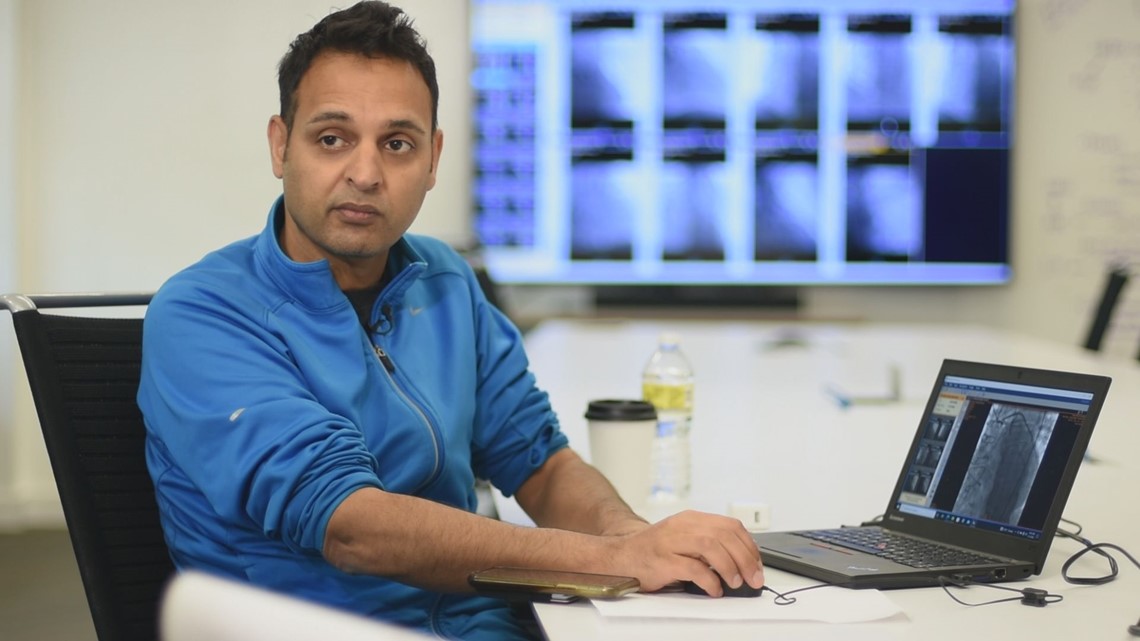
Morton Rinder, the Missouri cardiologist hired as an expert consultant to assist Lawton and Pflum’s legal team, agrees.
“There’s maybe 40% [blockage] at the most. This is unnecessary stenting,” he said after reviewing Lawton’s cath lab films.
Sunil Rao said he would not have implanted a stent either. The New York cardiologist and president of the Society for Cardiovascular Angioplasty and Interventions said, “In that LAD, no narrowing that would have warranted a stent whatsoever. My jaw dropped when I saw that.”
Doctors do double take
We asked the interventional cardiologists to look at films for another patient who’s filed a complaint against Harlamert. That patient, who asked not to be identified by 13News, received four stents from Harlamert in 2003.
“There’s absolutely no significant blockage in this artery,” Rinder said from his Missouri medical office as he looked at films showing the first area that Harlamert stented.
“It looked pretty normal to me. I didn’t see any blockage at all,” echoed Khan, who reviewed the same cath lab films at 13News.
Four days after Harlamert inserted the first stent, he performed another catheterization on the same patient and inserted a second stent. His medical notation said there was a 40% blockage.
Rao said both the procedure and the medical record are surprising. “There’s two issues there. First issue is, it’s not a 40% blockage. The second issue is we don’t stent 40% blockages,” he said.
Rinder saw the same thing and told 13News he “never” would have inserted the second stent in the patient’s blood vessel, which he said appeared to be only 10% blocked – far below the standard for implanting a stent.
“[Harlamert] called it 40% and then put another stent in. Even if you believed it was 40% blocked, you still wouldn’t put a stent in,” Rinder said.

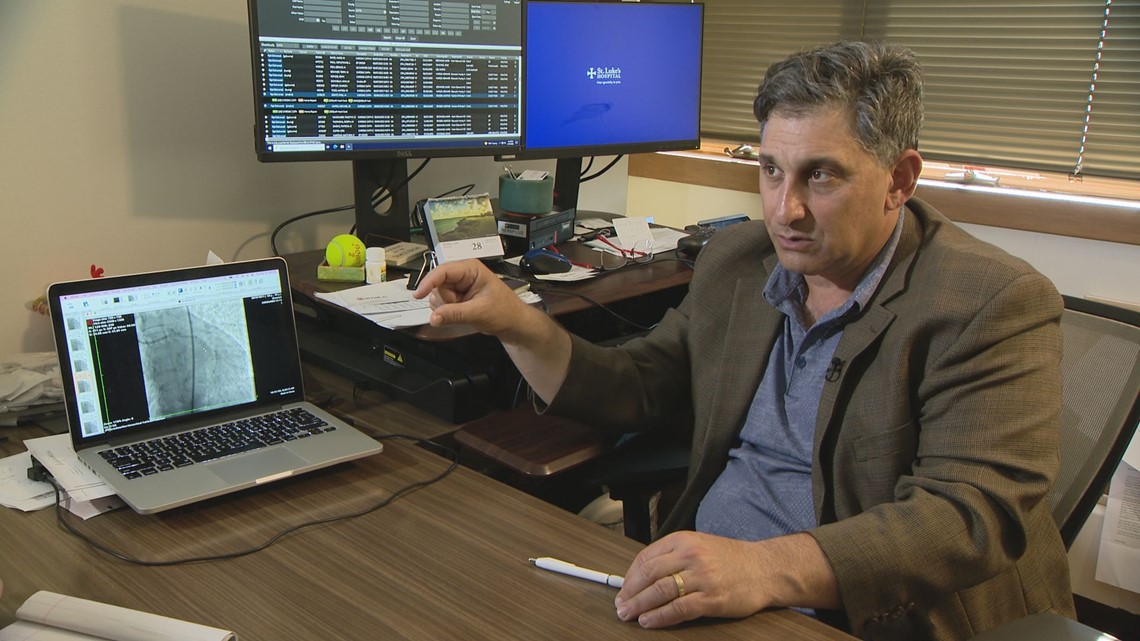
And just one month later, when the patient had more chest pains, medical records show another trip to the cath lab resulted in Harlamert implanting two additional stents.
Rao was incredulous. “There’s nothing that approaches any kind of severity that would warrant a stent,” the cardiologist said. “I did a double take on a couple of them because I’ve actually never seen anything that egregious before.”
“It is the first stent that led to the second stent, led to the third stent, and so forth,” Khan added.
And Rinder said he does not think any of the patient’s four stents were warranted.
“None of them needed to be put in. Unnecessary. Completely unnecessary,” he said.
Compelled to speak out
Like the Pflums, both the unnamed patient and Lawton are still waiting for medical review panels to consider their cases. The process can drag out for years.
In the meantime, Lawton says she is in agony every day because of the heart procedures performed by Harlamert.
“I could walk around here without a walker or without my cane. I could do the gardening. Now, I can’t do it,” she said.
Lawton told 13News she is now crippled and bed ridden, unable to walk or even feel her right foot, after a huge blood clot immediately developed in her groin in the same spot where Harlamert inserted the catheter wire for her heart cath. After that procedure, hospital records show Lawton went into shock, needed four units of blood, and nurses listed her prognosis as “grave” because of internal bleeding from that blood clot – all following a procedure she says she didn’t need in the first place.
Situations like that are why patients like Carlota Lawton and John Pflum are now speaking out.
“What about the next guy?” Lawton asked. “I’m just trying to protect other people.”
“Look, this has to stop,” said Pflum, who told 13News he is still recovering from post-traumatic stress syndrome following dozens of heart procedures. “Somebody else’s life could be at stake. It just needs to stop.”
If you believe you or someone you know has received inappropriate medical care from Edward Harlamert or from any other physician, 13 Investigates would like to hear your story. You can contact us at 13investigates@wthr.com.
Statement on behalf of Dr. Harlamert in response to 13 Investigates
For more than 30 years, Dr. Harlamert has treated his cardiology patients based on their unique circumstances, his expertise, and the tools available. When disputes arise about a medical professional’s treatment of patients, there is an Indiana statutory medical review process that is to be followed. In this process, all facts and evidence are presented to an unbiased medical review panel comprised of medical professionals. Dr. Harlamert has always been committed to providing quality care to patients. As previously stated, there is a legal process for these types of disputes, and it allows all parties the opportunity to investigate the claims and conduct discovery prior to the presentation of evidence to a panel of unbiased medical professionals. Because of stringent privacy laws and pending litigation, a response to a local news story is not the proper forum to present a picture of any particular treatment decision, especially when that picture may be incomplete at this time.
--Elliott I. Pinkie, Attorney, Pinkie Law LLC, and Kelly K. McFadden, O’Neill McFadden & Willett LLP
NOTE: 13News contacted all of the health care networks that are named in the malpractice claims involving Edward Harlamert. Community Health, Indiana University Health and Witham Health said they will not discuss the claims based on the pending litigation, and they would not confirm the dates for which they employed the cardiologist.


